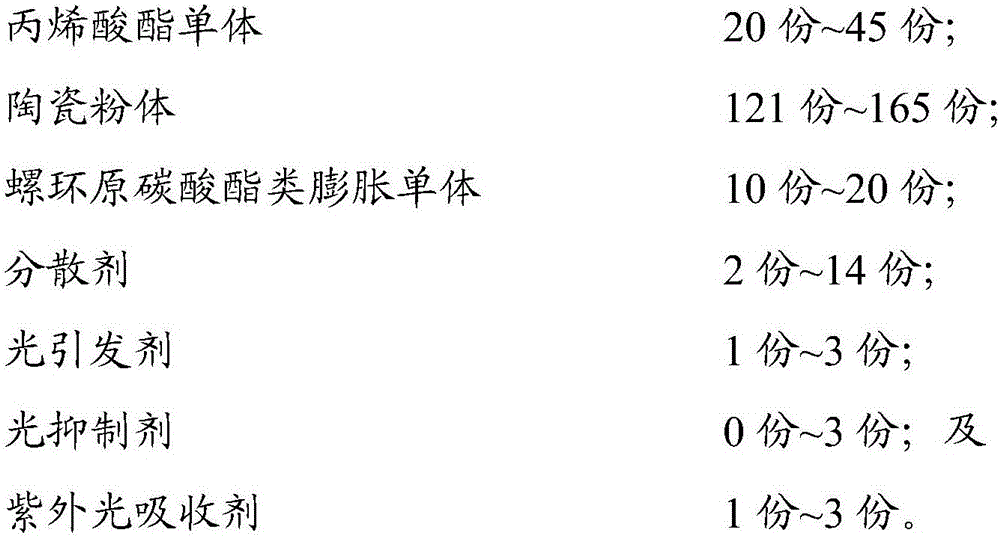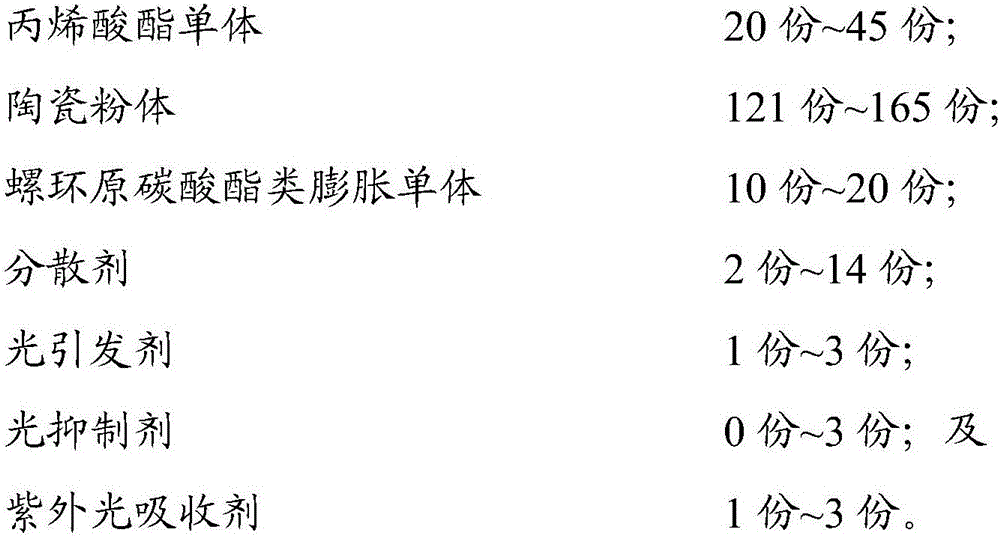Ceramic composite for 3D printing and preparation method thereof
A ceramic composite material and 3D printing technology, applied in the direction of additive processing, etc., can solve the problems of few types of 3D printing materials, inability to meet industrial applications, and lengthy manufacturing chain.
- Summary
- Abstract
- Description
- Claims
- Application Information
AI Technical Summary
Problems solved by technology
Method used
Image
Examples
preparation example Construction
[0039] The preparation method of the above-mentioned ceramic composite material for 3D printing comprises the following:
[0040] Step S 110, mixing the dispersant, the acrylate monomer and the spiro orthocarbonate expansion monomer to obtain a premix.
[0041] Preferably, if the acrylate monomer is a mixture of two monomers, the two acrylate monomers are uniformly mixed before being mixed with the spiro ring orthocarbonate expansion monomer and added to the dispersant.
[0042] Preferably, if the spiro ring orthocarbonate expansion monomer is a mixture of two expansion monomers, the two expansion monomers are mixed evenly before being mixed with the acrylate monomer and adding the dispersant.
[0043] Step S120, adding ceramic powder to the premix and then ball milling to obtain a mixture.
[0044] Preferably, the ceramic powder is gradually added to the acrylate monomer several times, more preferably, added to the acrylate monomer three times.
[0045] Preferably, the ball...
Embodiment 1
[0056] The preparation of the 3D printing ceramic composite material of embodiment 1 comprises the following steps:
[0057] An electronic balance weighed 17.78 g of hexanediol diacrylate (HDDA) and 2.22 g of ethoxylated pentaerythritol tetraacrylate (EPETA), and mixed and stirred the two resins.
[0058] Measure 10g of spirocyclic orthocarbonate expansion monomer 3,9-diethyl-3,9-propenyloxymethyl-1,5,7,11-tetraoxaspiraundecane (BAOM), add to the acrylate monomer mixture above.
[0059] Measure 2 g of diethylpolypropoxymethyl ammonium chloride (VARIQUAT CC-59 from Degussa Company) as a dispersant and add it to the above mixed monomers, and stir properly to obtain a liquid mixture.
[0060] The spherical silicon dioxide powder is sieved to obtain the required powder, the average diameter of the powder particles is 5 microns, and the diameter of 95% of the powder particles is less than 25 microns. Measure 121g of silicon dioxide powder, gradually add into the above liquid mixt...
Embodiment 2
[0065] 18.18 g of hexanediol diacrylate (HDDA) and 1.82 g of ethoxylated pentaerythritol tetraacrylate (EPETA) were weighed by an electronic balance, and the two resins were mixed and stirred.
[0066] Measure 10g of spirocyclic orthocarbonate expansion monomer 3,9-diethyl-3,9-dimethylol-1,5,7,11-tetraoxaspiraundecane (DHOM), add to the acrylate monomer mixture above.
[0067] Measure 5.2 g of polyamide hyperdispersant (SOLSPERSE 32000 from Noveon Company) and add it to the above mixed monomers, and stir properly to obtain a liquid mixture.
[0068] After sieving the spherical silica powder, the required powder is obtained, the average diameter of the powder particles is about 10 microns, and 95% of the powder particles have a diameter less than 25 microns. Measure 130g of silicon dioxide powder, gradually add into the above liquid mixture in three batches and stir after each addition to fully mix.
[0069]The mixture obtained in the previous step was then placed in a cerami...
PUM
| Property | Measurement | Unit |
|---|---|---|
| Diameter | aaaaa | aaaaa |
| Viscosity | aaaaa | aaaaa |
| Average diameter | aaaaa | aaaaa |
Abstract
Description
Claims
Application Information
 Login to View More
Login to View More - R&D
- Intellectual Property
- Life Sciences
- Materials
- Tech Scout
- Unparalleled Data Quality
- Higher Quality Content
- 60% Fewer Hallucinations
Browse by: Latest US Patents, China's latest patents, Technical Efficacy Thesaurus, Application Domain, Technology Topic, Popular Technical Reports.
© 2025 PatSnap. All rights reserved.Legal|Privacy policy|Modern Slavery Act Transparency Statement|Sitemap|About US| Contact US: help@patsnap.com



